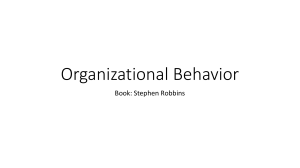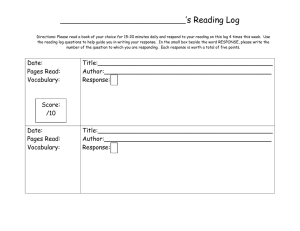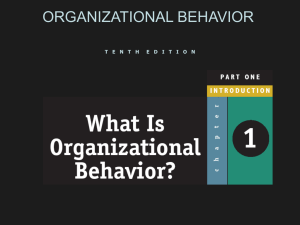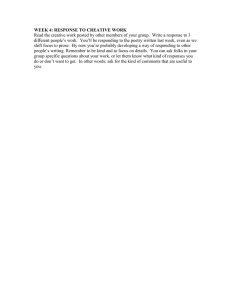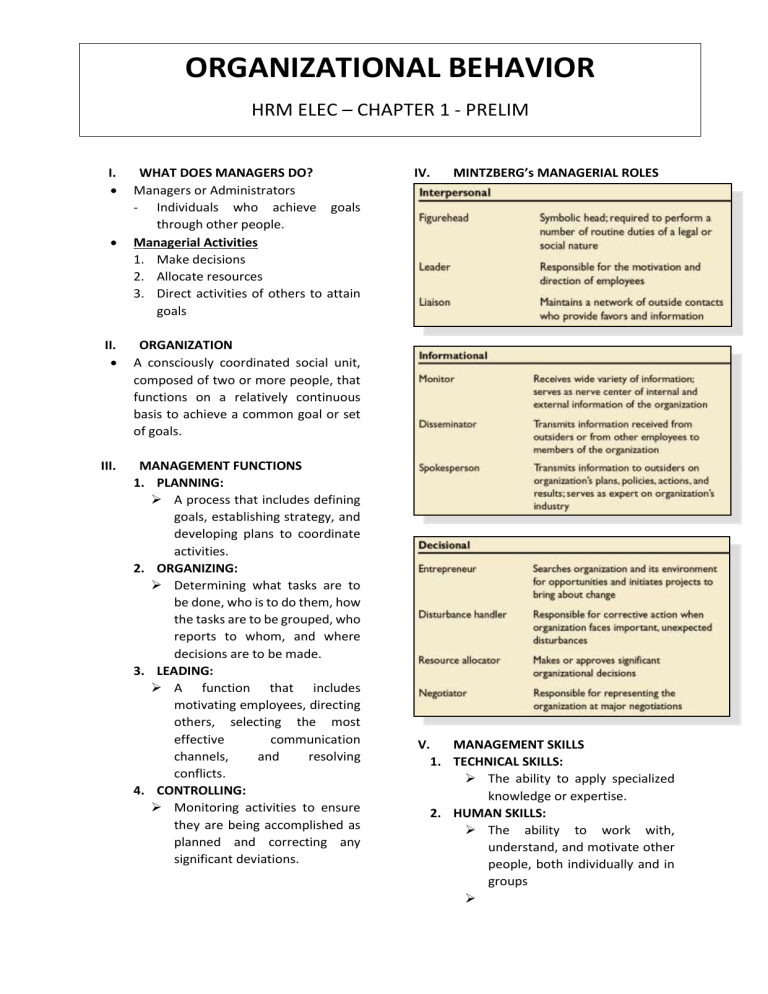
ORGANIZATIONAL BEHAVIOR HRM ELEC – CHAPTER 1 - PRELIM I. WHAT DOES MANAGERS DO? Managers or Administrators - Individuals who achieve goals through other people. Managerial Activities 1. Make decisions 2. Allocate resources 3. Direct activities of others to attain goals II. ORGANIZATION A consciously coordinated social unit, composed of two or more people, that functions on a relatively continuous basis to achieve a common goal or set of goals. III. MANAGEMENT FUNCTIONS 1. PLANNING: A process that includes defining goals, establishing strategy, and developing plans to coordinate activities. 2. ORGANIZING: Determining what tasks are to be done, who is to do them, how the tasks are to be grouped, who reports to whom, and where decisions are to be made. 3. LEADING: A function that includes motivating employees, directing others, selecting the most effective communication channels, and resolving conflicts. 4. CONTROLLING: Monitoring activities to ensure they are being accomplished as planned and correcting any significant deviations. IV. V. MINTZBERG’s MANAGERIAL ROLES MANAGEMENT SKILLS 1. TECHNICAL SKILLS: The ability to apply specialized knowledge or expertise. 2. HUMAN SKILLS: The ability to work with, understand, and motivate other people, both individually and in groups 3. CONCEPTUAL SKILLS: The mental ability to analyze and diagnose complex situations. IX. VI. EFFECTIVE versus SUCCESSFUL MANAGERIAL ACTIVITIES (Luthans) 1. Traditional management Decision making, planning, and controlling 2. Communication Exchanging routine information and processing paperwork 3. Human resource management Motivating, disciplining, managing conflict, staffing, and training 4. Networking Socializing, politicking, and interacting with others VII. COMPLETING INTUITION AND SYSTEMATIC STUDY INTUITION: “Gut” feelings about “why I do what I do” and “what makes others tick”. SYSTEMATIC STUDY: Looking at relationships, attempting to attribute causes and effects, and drawing conclusions based on scientific evidence. Provides a means to predict behaviors. ALLOCATION OF ACTIVITIES BY TIME X. CONTRIBUTING FACTORS TO THE OB FIELD Psychology The science that seeks to measure, explain, and sometimes change the behavior of humans and other animals. VIII. ENTER ORGANIZATIONAL BEHAVIORS Organizational Behavior (OB): A field of study that investigates the impact that individuals, groups, and structure have on behavior within organizations, for the purpose of applying such knowledge toward improving an organization’s effectiveness. Sociology The study of people in relation to their fellow human beings. XI. FEW ABSOLUTES IN OB Contingency variables: Depends!!!" Situational factors that make main relationship between variables change---e.g., relationship may hold for condition but not another. XII. Social Psychology An area within psychology that blends concepts from psychology and sociology and that focuses on the influence of people on one another. 1. 2. Anthropology The study of societies to learn about human beings and their activities. "It the two the one CHALLENGES AND OPORTUNITIES IN OB Responding to Globalization Increased foreign assignments Working with people from different cultures Coping with anti-capitalism backlash Overseeing movement of jobs to countries with low-cost labor Managing people during the war on terror. Managing Workforce Diversity Embracing diversity Changing U.S. demographics Implications for managers Recognizing and responding to differences 3. Improving Quality and Productivity Quality management (QM) Process reengineering 4. Responding to the Labor Shortage Changing work force demographics Fewer skilled laborers Early retirements and older workers 5. Improving Customer Service Increased expectation of service quality Customer-responsive cultures 6. Improving Quality and Productivity 7. Quality management (QM) 8. Process reengineering 9. Responding to the Labor Shortage 10. Changing work force demographics 11. Fewer skilled laborers 12. Early retirements and older workers 13. Improving Customer Service 14. Increased expectation of service quality 15. Customer-responsive cultures XIII. 1. 2. 3. WHAT IS QUALITY MANAGEMENT? Intense focus on the customer. Concern for continuous improvement. Improvement in the quality of everything the organization does. 4. Accurate measurement. 5. Empowerment of employees. XIV. BASIC OB MODEL, STAGE 1 MODEL: An abstraction of reality. A simplified representation of some real-world phenomenon. Dependent variable A response that is affected by an independent variable (what organizational behavior researchers try to understand). 1. Productivity A performance measure that includes effectiveness and efficiency. 2. Effectiveness Achievement of goals. 3. Efficiency Meeting goals at a low cost. 4. Absenteeism The failure to report to work. 5. Turnover The voluntary and involuntary permanent withdrawal from an organization. 6. Deviant Workplace Behavior Voluntary behavior that violates significant organizational norms and thereby threatens the wellbeing of the organization and/or any of its members. 7. Organizational citizenship behavior (OCB) Discretionary behavior that is not part of an employee’s formal job requirements, but that nevertheless promotes the effective functioning of the organization. 8. Job satisfaction A general attitude (not a behavior) toward one’s job; a positive feeling of one's job resulting from an evaluation of its characteristics. Independent variable The presumed cause of some change in the dependent variable; major determinants of a dependent variable. XV. BASIC OB MODEL, STAGE 2
